Monday, June 12 – Saturday, June 17
June 12 is Philippine Independence Day and IRRI was given the day off to celebrate. We decided a good way to do so was by admiring the natural beauty of the Philippines and visiting the Makiling Botanical Garden. The five of us started our outing thinking that we would be taking an easy stroll through some native plants, but we were in for an unexpected surprise. The Ecotrail Path that we were following turned into more of a challenge than any of us were expecting. The long winding road through the trees soon became steep steps that led us to a worn-down, natural path weaving through the forest. With the slippery mud coating the “steps” formed by the roots of the trees and the intense buzzing of insects that seemed to fill the entire forest, our leisurely walk was anything but. The scenery was beautiful, but it was hard not to want anything more than to be clean, showered, and relaxing in air conditioning. We eventually made our way out of there, appreciative of the Filipino nature, but also of the fans that greeted us in the Garden’s Welcome Center, where we rested and examined an intricate diorama of the wildlife before making our way home.






Since it was a holiday, the IRRI shuttle was on a different schedule and there weren’t many jeepneys out, so we walked home, taking what we were told was a shortcut through the mountains. After a nice long shower and a full meal at the canteen, I fell asleep and rested.
Unfortunately, when I woke up I realized that I was sick. I had been feeling a little off but had chalked it up to our fun weekend out and spontaneous hike, but it turns out I had been sick when we went on that hike. I immediately took my temperature and was relieved when there was no fever, but still took some of the medicine I had brought with me from home. I went to work with my mask on and immediately came home, took more medicine, and rested. Thankfully, it wasn’t anything more than a rough cold, but together with the homesickness that was finally hitting me and the lack of things that are usually readily available when I’m sick at home (like a mug to make tea), I felt a lot worse.
On Wednesday, it was almost as if my coworkers knew exactly what I needed, as they took me to the canteen for our meryenda and had me try one of the best things I have tasted in the Philippines yet: turon. It’s basically a banana that has been wrapped with lumpia paper, fried, and coated in brown sugar and sometimes caramel, and that warm sweetness was just what I needed to brighten my spirits. I was still settling into my new environment and getting used to miscommunications at work, not understanding the language, new foods, and generally being in a completely new place, but something as small as a fried banana helped to snap me out of some of that and feel a bit better.

Thursday was another typical day at work as I focused on getting into a groove with my research and was starting to feel like I was recovering from my cold. Dr. Jongsoo brought us back some sweets from Vietnam and everyone had thought that they were coffee grounds, but it was actually a mung bean cake! It was sweet, and very loose and crumbly, tasting a bit like vanilla. At lunch, everyone tends to share their food and there’s a pile of collected pasalubong from the office’s work travels that sits at the center of the table. My coworkers told me that if a Filipino doesn’t share their food with you, they don’t love you, so it’s nice that they consistently offer me some of their meals. They have also told me that, unlike in some other Southeastern Asian countries, Filipinos don’t really go out to eat very frequently. This is because some of the best meals are cooked in their homes, and the food and recipes are just different when they are homecooked. As much as I love the food at the IRRI canteen and am grateful for the easy accessibility, I could definitely taste the difference between my coworkers’ meals and my own, as theirs had that homecooked feel that buffet style can’t quite capture. I was able to try some meat that had been wrapped and cooked in leaves, a refreshing papaya salad, and a Philly cheesesteak that reminded me of home.
On Friday, we had another IRRI orientation, but this time it was with more student interns. Most are completing their master’s degrees and are writing their theses here while doing research, and it was really interesting to meet all these new people. The sit-down orientation mainly talked about ASFRI, an organization at IRRI that is focused on the involvement and engagement of visiting scholars and interns. They organize group field days, shopping trips to Manila, sports leagues, and social hours where we can get to know one another better.

After another short orientation on internet safety and library services in the IRRI conference room, we had a quick coffee break at the Beanhub, IRRI’s coffee shop, and were able to finally socialize with the other interns. I finally met other social science people! Lu and Stefano, both completing their master’s at Columbia University in New York, are studying more of the social sciences and it was so cool to talk to them, hear what they are working on, and actually understand, which does not always happen or come as easy with my hard science IWU friends here with me at IRRI. Stefano actually also studied literature in college and almost had a concentration in Modernist Literature, my favorite genre, so we had a great conversation about our favorite works and authors, such as Virginia Woolf, William Faulkner, Wallace Stevens, and Djuna Barnes. Both Lu and Stefano are working more on policy development and marketing, and they are in offices similar to mine. This was also my first time at the Beanhub, and the cozy atmosphere, delicious treats, and great espresso made for the perfect environment to get to know new friends.


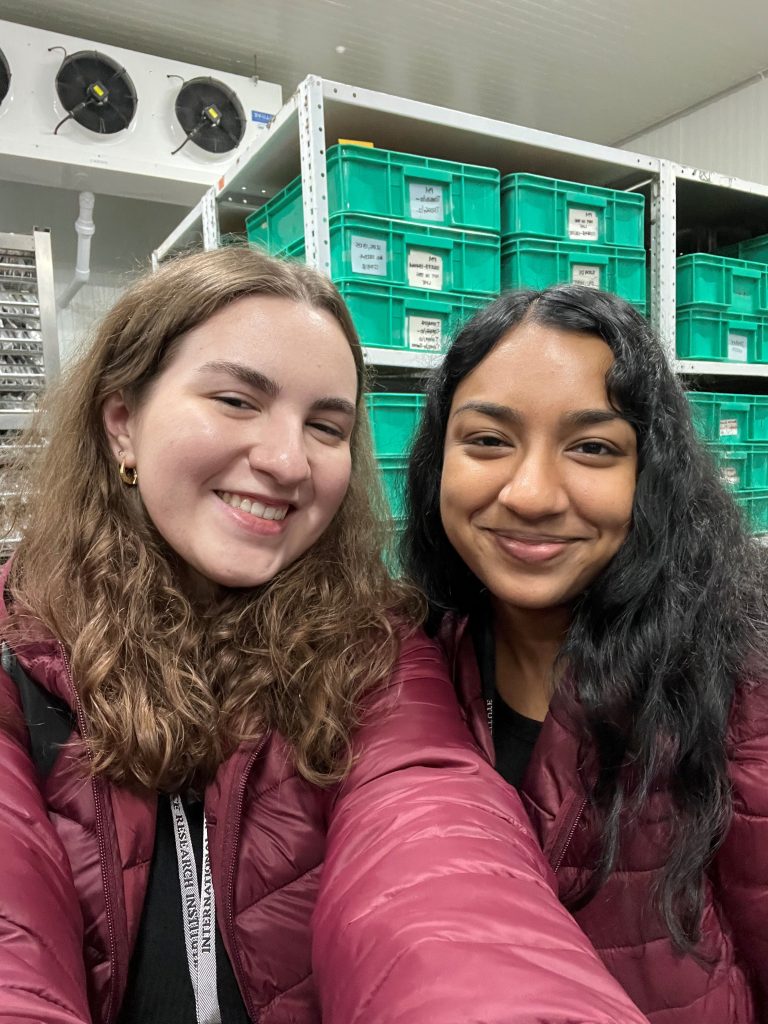

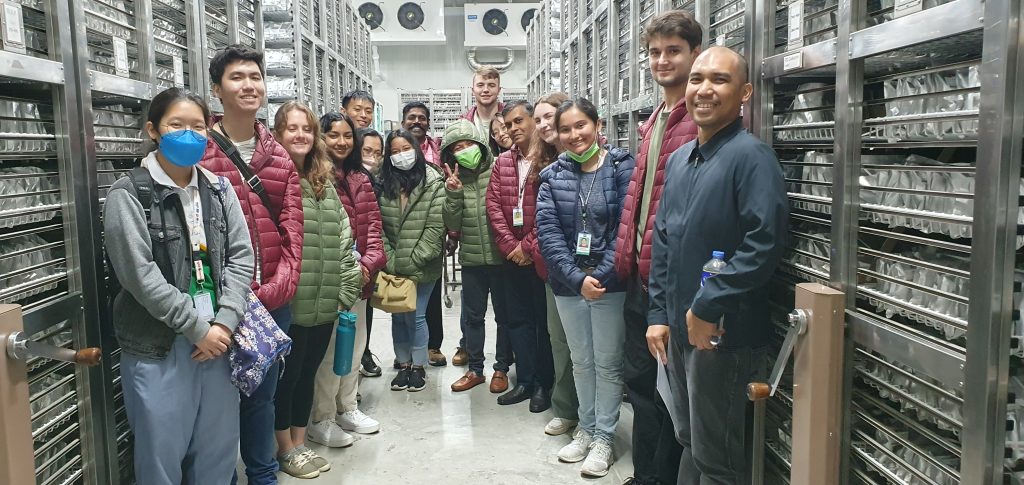


The rest of the day was the grand tour of the IRRI property, starting with their pride and joy, the Gene Bank. IRRI’s Gene Bank holds thousands of samples of rice, preserving them for research and conservation. There are two sections, the active storage that stays at a crisp 2 to 4 degrees Celcius and holds rice for a shorter period of time, typically samples that will be taken out again. The next section is the base storage, and much, much colder at -18 to -20 degrees Celcius. Some of the rice inside has been there since the 1960s! There is also a Gene Bank in the Arctic, and the last time anything was placed inside was in February 2020. There are various reasons why strains of rice are kept in the Bank, the main one being preservation. Due to invasive species, evolution, climate change, and other factors, certain varieties of rice may be dying out or no longer able to grow on their own in the wild. Therefore, IRRI holds on to some of them for research, innovation, and any possible need for the future. A researcher can request a sample of some of the rice specimens in the Gene Bank for their research, and throughout the day we would witness the process of how the rice moves from the Bank to them.

Next door the Gene Bank, we shed our coats and huddled around the table to see a sample of rice that had been pressed and preserved all the way from 1960. It’s interesting to think about how long some of this rice, or the rice recently being put in, will be preserved in the Gene Bank…
The tour kept moving right along to other labs where we were able to see how the rice seeds get processed, packaged, and ready to be sent to researchers who requested them.
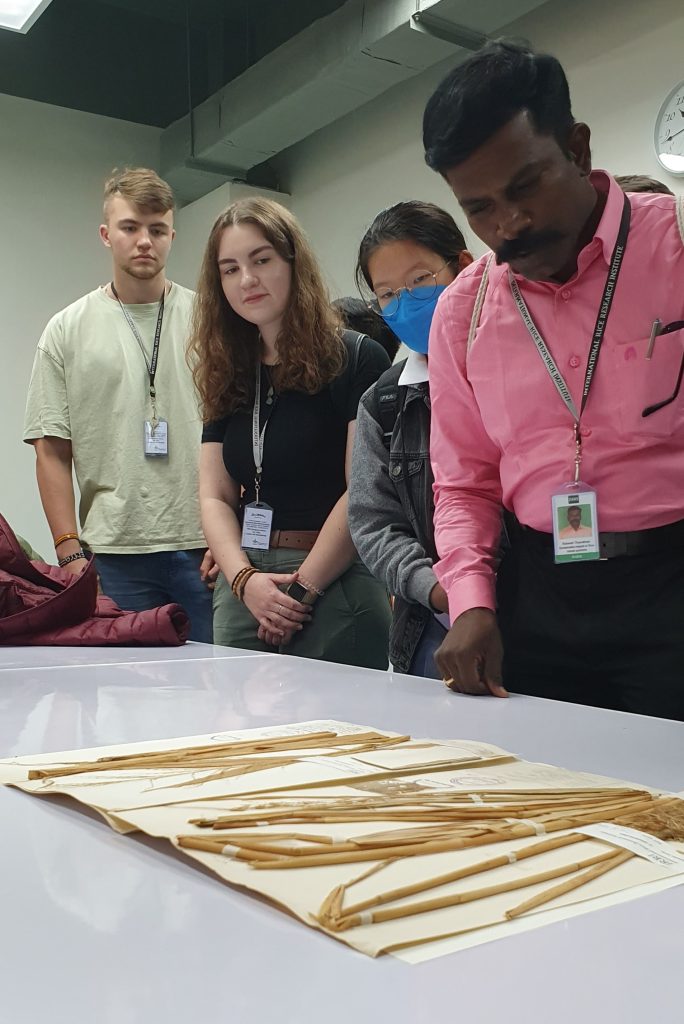
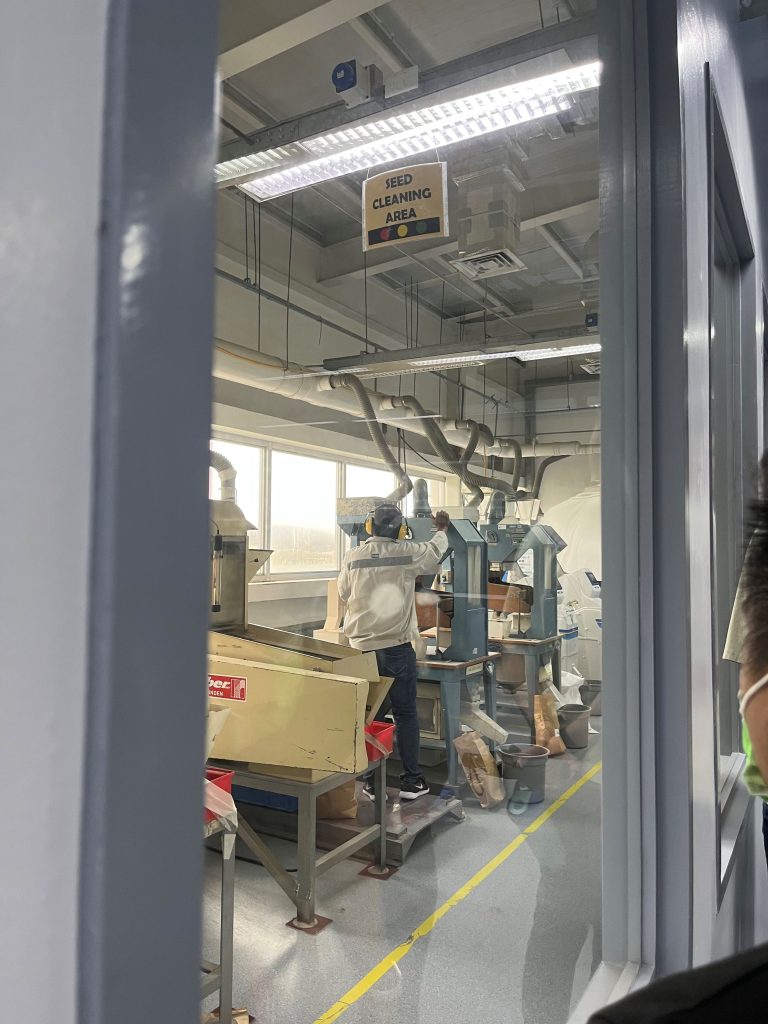




We got to see some of the high-tech chambers and glasshouses where IRRI is conducting its own research. There are different kinds and sizes for all different types of studies. One of the glasshouses is even able to adjust the pressure inside when it senses that there is change, therefore keeping a stable environment for the rice.
We had a quick lunch break and played some ping pong in the gym before getting back on the shuttle and heading out towards the fields. IRRI is developing and testing many new strains of rice, most of which grow right across from my dorm. However, the entire property of IRRI, which is nestled inside the campus of the University of the Philippines Los Banos, is roughly 256 hectares, and there is much more rice that we can’t always see. We drove around with one of the IRRI scientists who described the fields that we were passing, some of which are used to simulate floods or constant rain to test rice that may withstand those conditions. There are greenhouses that simulate drought to test drought-resistant strains, and fields with extreme salinity levels to test the strength and adaptability of these new stains.
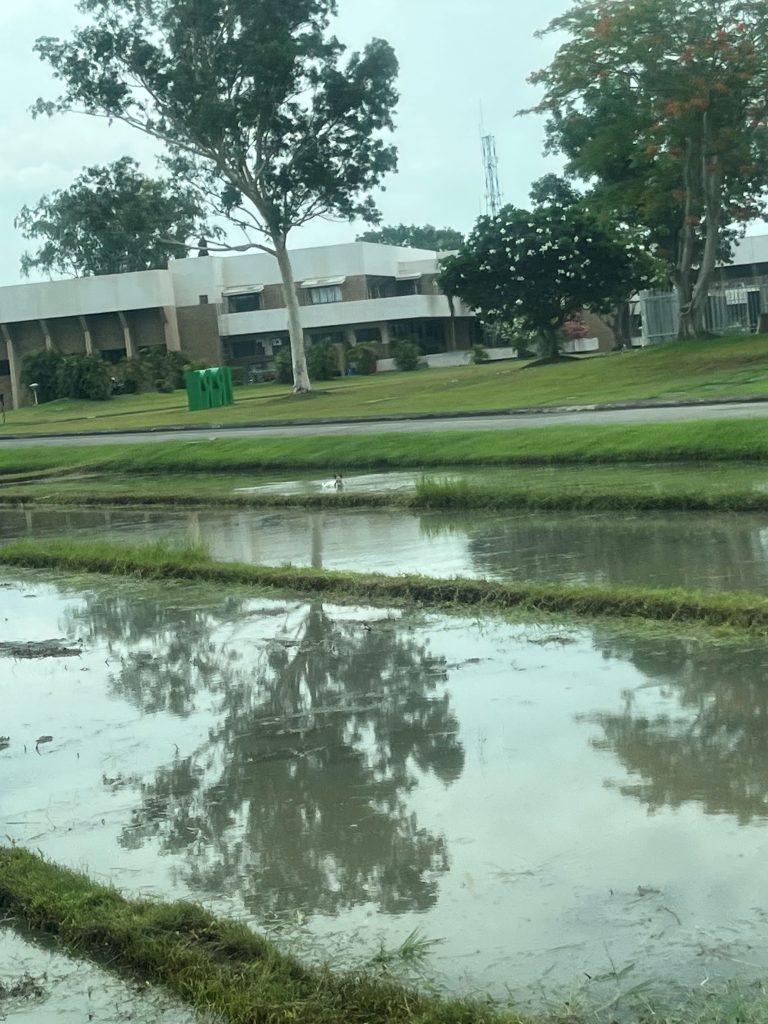






Much of this rice is developed and distributed in response to climate change. Certain existing or wild strains of rice already have the genetic capability to withstand these conditions, and when genetically engineered with rice native to the target area, for example, Kenyan farmers experiencing extreme and unpredictable droughts after being forced to move from their familiar rainfed farming systems, IRRI can help farmers be able to produce sustainable crop yields, improving food security and decreasing poverty levels.

We made one last stop at another lab where a scientist explained how she actually goes about doing the genetic science with rice samples collected from the IRRI fields we just drove through. Lu, Stefano, and I dutifully nodded along and had a general understanding of what she was saying, but the larger group seemed to hang onto every word she said and grasped it to a greater extent. Either way, it was extremely interesting and informative; I felt smarter just being there!
That concluded our tour and we walked back to Harrar Hall, our dorm, to get ready to go out to LB. We went shopping at the mall and popped into a bookstore to browse and get some tape. This was my first time in the retail section of a Filipino mall, and everyone is very attentive. It caught me slightly off guard when the employees were always looking at us or hovering near, but once you understand they’re only doing their job the discomfort lessens a bit.

We walked out with our purchases and headed to a restaurant called Spice Jar, a self-proclaimed Tex-Mex joint that had lots of burgers, tacos, and quesadillas. They had birria tacos that I had been wanting to try, but it felt somewhat blasphemous to get them for the first time in the Philippines, so I opted for the chicken tacos. I did not know that Mexican food would be so comforting at this moment, but it was exactly what I needed. After a filling meal, we made our way back to IRRI to rest up for our big day out tomorrow at Villa Escudero.

Seeing the sunrise made me feel slightly better about my decision to go to Villa Escudero at 6 am. Half asleep, but filled with excitement, we boarded the IRRI bus with some of our fellow interns and scholars and started driving to Quezon. Along the way we passed through a town that appeared to be having a pineapple festival, as the streets were flooded with the fruit, vendors jammed onto the sidewalks, and a giant pineapple hoisted in the center of the square.
I almost wanted to stop and buy some (there were deals as low as 3 pineapples for 70 pesos!) but we kept on driving and soon arrived.
For context, Villa Escudero is a coconut plantation that was founded in the late 1800s, but now boasts many attractions such as a museum, cultural show, and lunch at the foot of a waterfall.
The entrance opens up to a grove of coconut trees, with grazing caribou scattered throughout, until you round a bend and arrive at the welcome center. We were greeted with some refreshing juice with jelly slices in it and checked ourselves in. The price was not bad for all that it included, as we were guaranteed entrance to the museum, a caribou ride, a waterfall lunch, and access to the rec center which included the pool, rafting in the river, the cultural show, and much more.



Our first stop was the museum, which, like many of the buildings, stands out with its bright pink coloring. Everything inside is a part of the Escudero family’s own private collection from their travels and no photos are allowed. From the outside, it looks almost religious, and that is reaffirmed by the first exhibit, life-size displays and floats of Catholic religious scenes. There was a Last Supper display where everyone was wearing traditional Filipino formal wear and an altar that was entirely made of silver. The floats seemed to be from a parade or procession that would take place near Easter, as they were large depictions of the Stations of the Cross.
The upstairs moved in sections, with preserved bugs, butterflies, underwater creatures, and animal skulls dating back to the early 1800s. Set in little dioramas, many of the specimens were frail and some crumbling, but it was incredible to think that they had been on this earth for as long as they have.
We moved along and saw painted portraits of Indigenous Filipinos from all different parts of the archipelago as well as original tools, jewelry, and artifacts from their respective nations. Once again, I was struck by how old some of these pieces were and wondered about the lives of the people whose portraits were displayed in front of me. The next diorama was back to animals, and while I am not an avid fan of taxidermy, I am glad that it has progressed, because most of these were terrifying to look at. The worst was definitely a small leopard whose placard described how they were once in the circus but had to be put down after killing someone, as the eyes were popping out of the head and the skin on the face was pulled in a way that looked unnatural. Once again, this leopard had been around since the 1800s.
I probably could have spent all day in this museum, as it was full of knickknacks, treasures, and plenty of historical descriptions. There was pottery and china that had been discovered on shipwrecks in the 1800s, small housewares that had been brought over by Chinese merchants, and handcrafted and painted jewelry. There were dioramas depicting a burial method that had been adopted in coastal areas once there started to be a lot of traffic, where people would place the remains in extremely large jars of stone or clay, and would then put them to rest in caves so as to protect them from pillaging from outsiders.
The next historical section focused on the fight for Filipino independence from Spain and contained extensive records of executions and prosecutions. There were garments worn during massacres, pictures taken at mass executions, and huge books filled with letters and declarations. It was
The display that followed was Filipino fashion trends throughout the ages and historical outfits of government officials, and while the garments were beautiful, the lifesize, realistic mannequins they were worn on were unsettling. I walked a bit faster through this section but was greeted with more of the same in the next, only this time it was military dress from centuries ago up until the mid-1900s, followed by a massive display of weapons. I quickly exited the museum and met up with the group outside.

We continued to walk through the grounds and admire the statues and sculptures littered throughout until we found another bright pink building and what appeared to be a center square with an old Filipino national anthem. It wasn’t long, though, until our next ticket item would arrive: the caribou ride! Our group piled into the massive trolley and our caribou, Madonna, took us away. There were also two Villa Escudero employees with us who strummed and sang a song with a ukelele, serenading us on our peaceful ride through nature.
Madonna dropped us off in front of a gift shop with an ice cream stand out front, so, to honor her, we got a scoop of ice cream and cooled down. I’m not 100% certain, but I’m pretty sure that it was cheese flavored, as a lot of Filipino desserts tend to contain cheese. As began to look around, we noticed signs directing us towards waterfalls, so, directly disobeying TLC, we chased them and found where we would be eating our lunch later. We also found the rest of the rec center, and although the volleyball section we were looking for was not really functional, there was still plenty to do.


First on the agenda was to simply admire the view because it was truly spectacular. The morning sun bounced perfectly off of the river that led straight to a nearby mountain. Once we saw the river we noticed the bamboo rafting and immediately got in line. Hannah and I paired up, as her sailing instructor skills and my past kayaking experience made us a pretty good team on the water, and we successfully boarded the raft without falling. While there wasn’t much to go or really anywhere to go because the river is sectioned off, it was still an amazing experience. We found some floating coconuts while floating in the shade, bumped into the Jessicas, and raced Sam and his partner back to the dock.

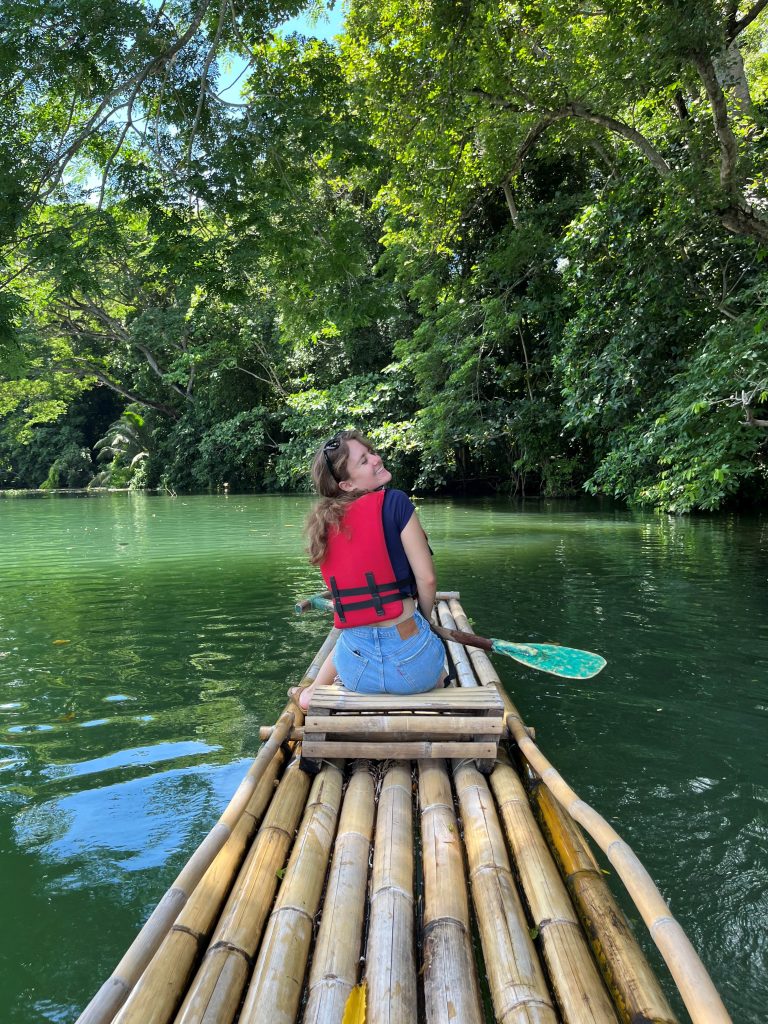
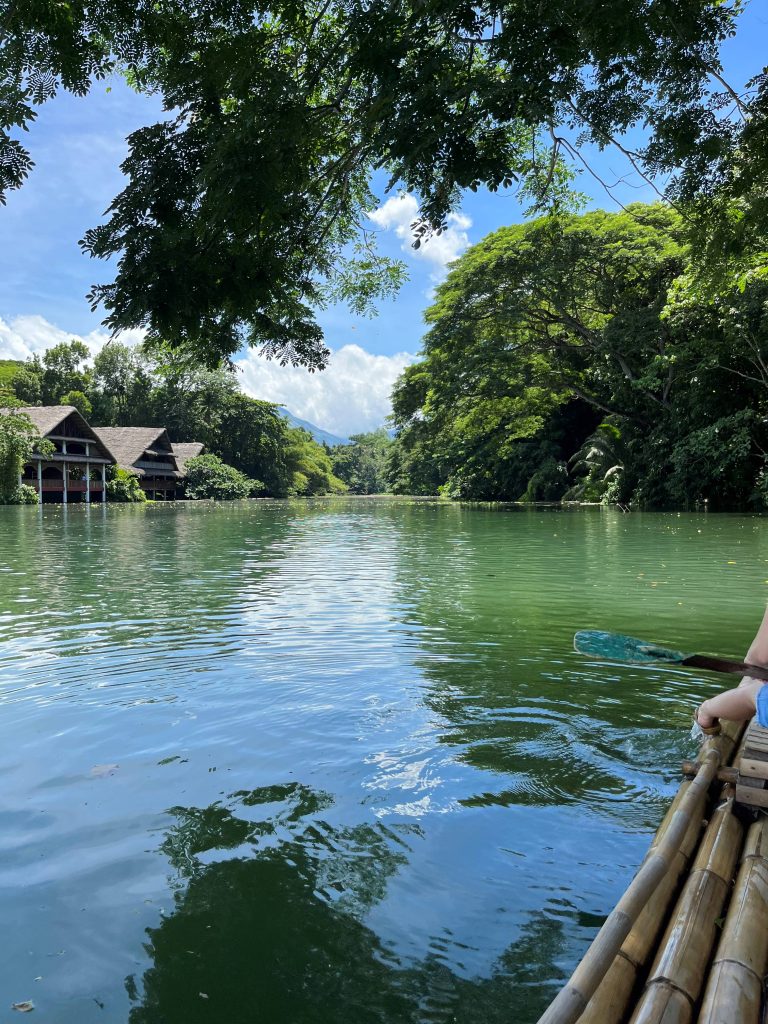


After sitting in the sun for so long we all needed to cool off, so we headed over to the 18+ pool, which was thankfully a lot quieter than the kiddie section. It had been so long since I was in a pool and it was exactly what I needed, as I was still adjusting the heat of the Philippines. The jacuzzi Jessica Issac and I attempted to sit in was broken, and some older women invited us to join them in theirs once they noticed us struggling. The water was cool, but the conversation was warm and friendly. The five of them had been friends since high school and were meeting up with their families for a nice day out. They were very interested in our internships and also, like most people we would meet, offered plenty of suggestions for things to do during our stay in the Philippines. Since their scheduled lunch time was before ours they left and we got back into the pool and got some sun, found some flowers, and played a game of Marco Polo before heading down for lunch.

While the pool was refreshing, lunch at the waterfall was an entirely new sense of refreshment. The shade from the trees, combined with the cool water covering your feet, and a delicious meal, was absolutely perfect. The five of us sat and ate with Lu and Stefano before taking some pictures and exploring the waterfall area.



At that point, we were all pretty tired after swimming and being out in the sun, so we decided to get some coffee at the cafe and head back to IRRI. However, on our way to get our drinks, we stumbled upon a cultural show! There was a dance troupe performing various styles of Filipino dance, some more traditional and others with Spanish influence. Two of the dance involved balancing things throughout, one was glasses of water and the other was lit candles. There was also a live band and the dance troupe brought out instruments at the end too. Everyone was so graceful and extremely talented. We stayed for the show and sat in the shade with our drinks after.
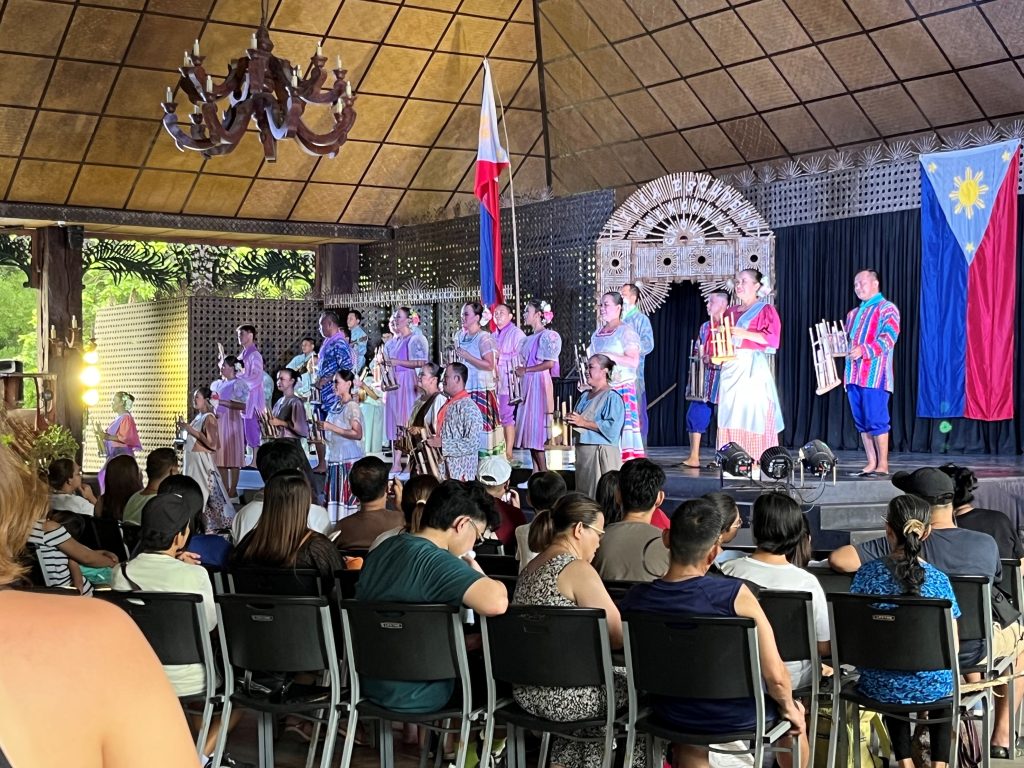

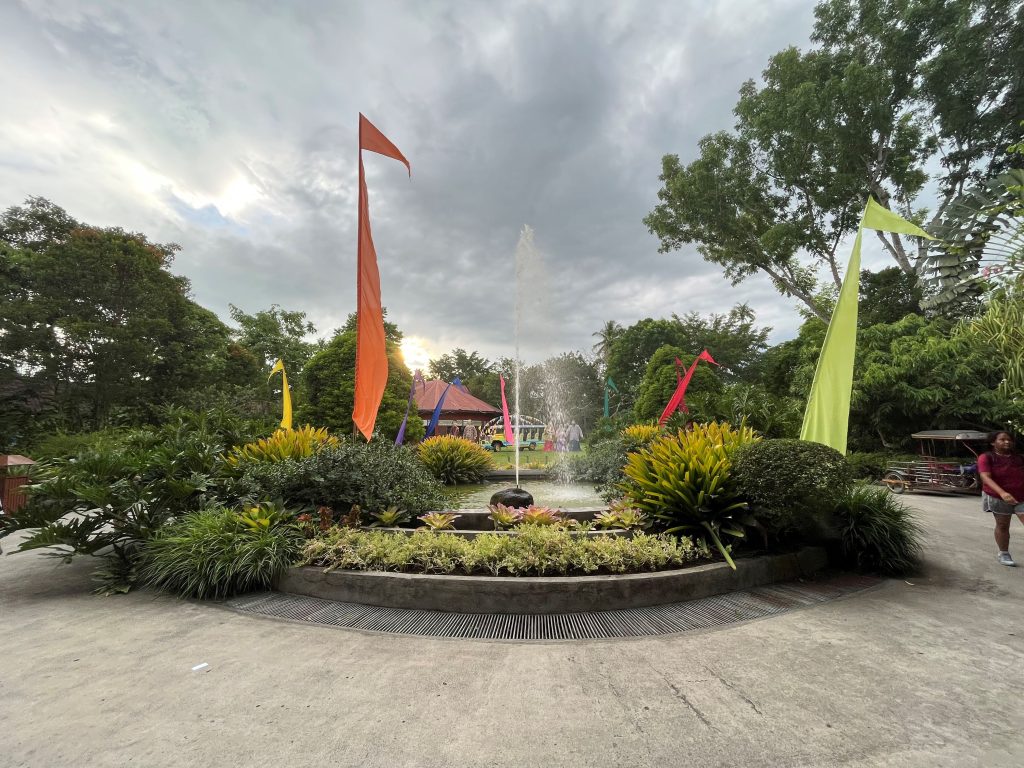
Some of the other members of our group wanted to swim again, and as nice as the first swim was, we were all pretty tired, so we found a table nearby and talked while they went back to the pool. It was nice to talk more, just the five of us, as we still didn’t really know each other very well. We all work separately during our internships and hadn’t spent much time together just sitting around and talking. Time passed quickly, as it tends to do with good conversation, and we were soon heading back and boarding our shuttle to IRRI.
The drive home was peaceful and there was a beautiful sunset and the sunburn started to settle on my skin. We arrived just in time for dinner and got some food before deciding to go out again later and explore Los Banos at night.
